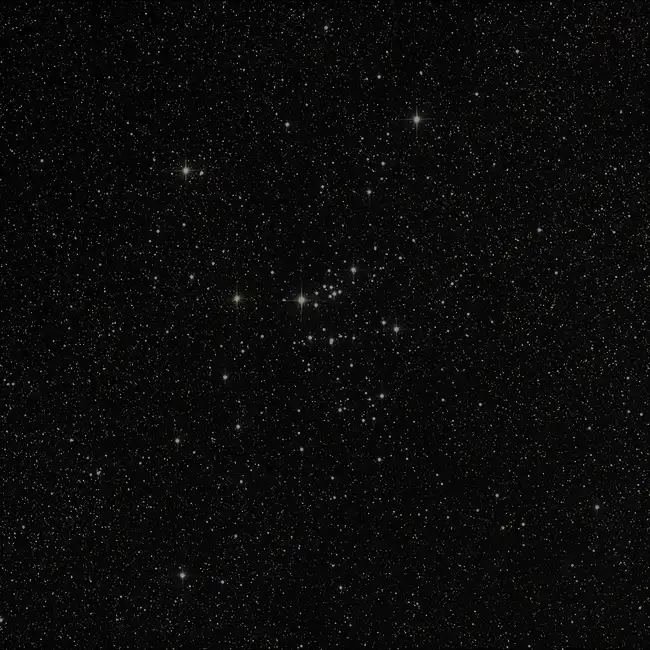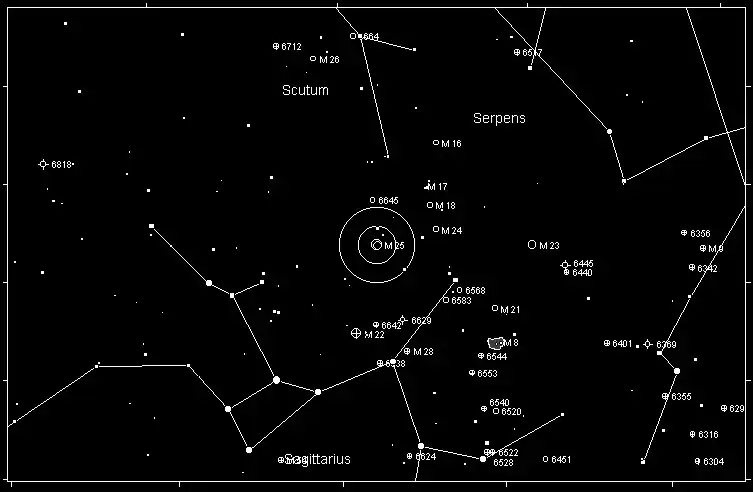Messier 25 (M25), also designated as IC 4725, is an open star cluster in the constellation of Sagittarius. It was discovered by Philippe Loys de Chéseaux in 1745 and included in Charles Messier's catalog in 1764. The cluster boasts an impressive array of over 600 stars, spanning a diameter of about 19 light-years. Situated approximately 2,000 light-years from Earth, M25's stars are relatively young, averaging 90 million years old. The cluster predominantly consists of luminous, hot, blue-white stars, with several evolved red giants contributing to its varied composition.
Magnitude: With an apparent magnitude of 4.6, Messier 25 is discernible to the naked eye in perfect dark-sky conditions. Its splendor is enhanced when observed with binoculars or a small telescope, which allows for the resolution of its individual stars.

Season of Prominence
M25 is best observed in the summer months, particularly from June through September. During this time, the constellation Sagittarius is prominently visible in the southern sky for observers in the Northern Hemisphere, providing an excellent opportunity to spot this cluster.
Constellation
Messier 25 is located in the constellation Sagittarius, often referred to as "The Archer." Sagittarius is one of the most recognizable constellations in the night sky due to its distinctive "Teapot" asterism. The constellation is rich with other celestial objects, including nebulae, star clusters, and even the center of our galaxy, the Milky Way.
How to Find M25
To locate Messier 25, you’ll want to start by finding the constellation Sagittarius. The Teapot asterism serves as a great landmark. Once you’ve identified the Teapot, look towards its "spout" and slightly northward. M25 is located about 3.5 degrees northwest of the bright star Mu Sagittarii. In binoculars or a small telescope, M25 will appear as a dense collection of stars. With larger telescopes, you can resolve even more stars and explore the rich structure of the cluster.

History
Messier 25 has a history intertwined with some of the early catalogers of celestial objects. Philippe Loys de Chéseaux first noted this cluster in 1745, though it did not gain much attention at the time. In 1764, Charles Messier added M25 to his famous catalog of "fuzzy" objects, which were often mistaken for comets. Messier’s goal was to create a reference list of such objects to avoid confusion during his comet-hunting activities. M25, being a relatively large and bright open cluster, earned a place in this catalog as the 25th object. Over the centuries, M25 has been studied for its star population and characteristics, with astronomers discovering that it is not just a loose collection of stars but a gravitationally bound cluster with stars sharing a common origin.
Conclusion
Today, M25 remains a popular target for amateur astronomers, especially during the summer months, when Sagittarius dominates the sky. Whether viewed through binoculars or a more advanced telescope, the beauty and history of Messier 25 continue to captivate stargazers across the world.
